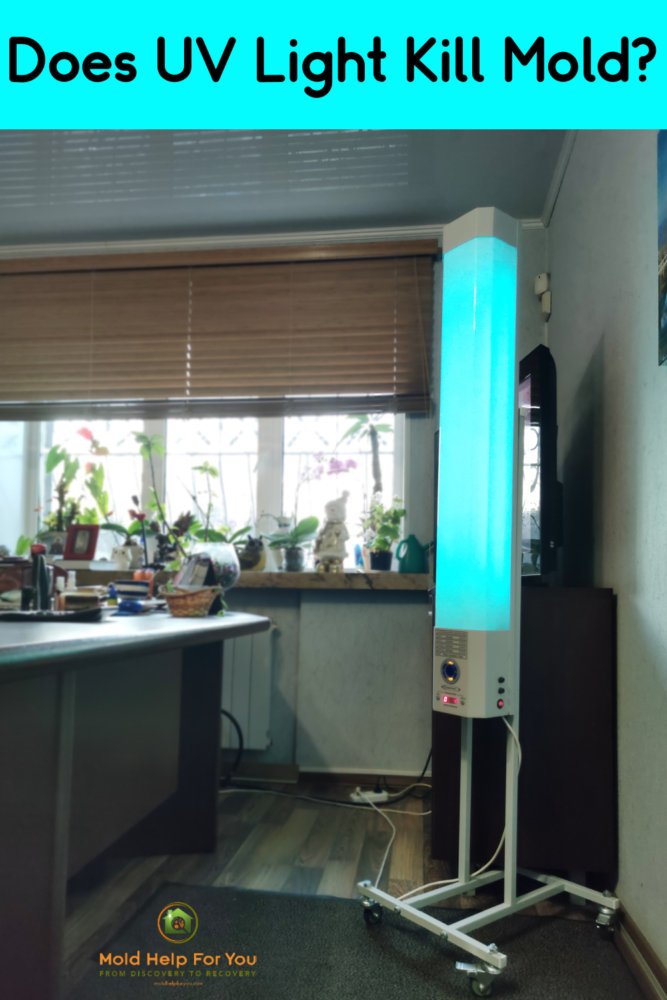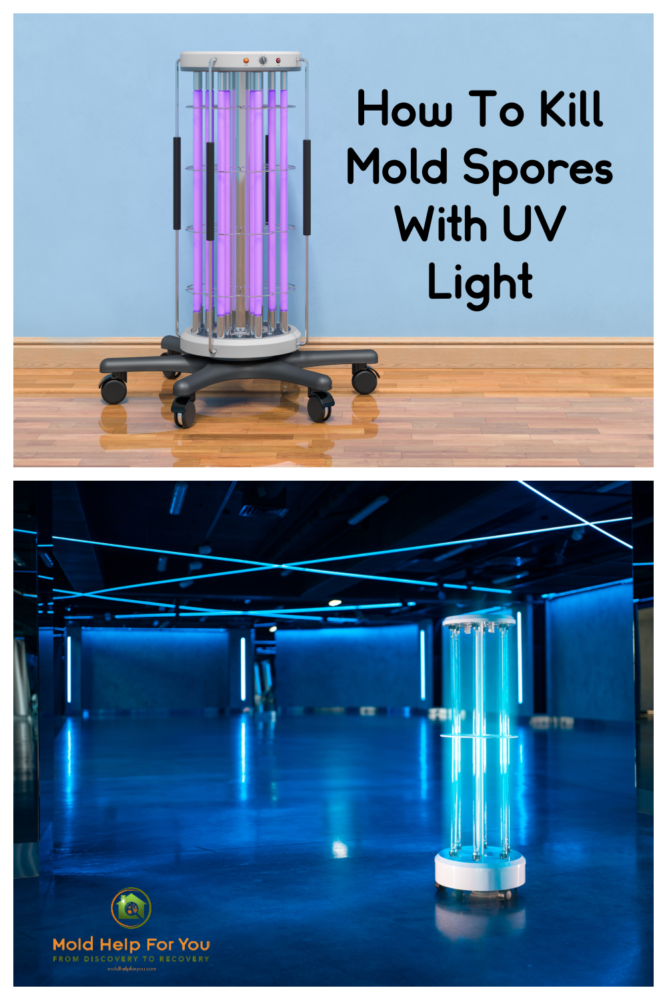Does UV Light Kill Mold?
This post may contain affiliate links. Read our full disclosure.
Ultraviolet lights and lamps have long been marketed as the best way to kill mold. Plug a UV light in and like magic your mold problems disappear. But do they really?
Before you dive into this article, I suggest you read another recently published article on whether or not sunlight kills mold. This will give you a better understanding of UV light in general and there are several references to that article here.
What Is UV Light?
Ultraviolet light (UV) is the part of the electromagnetic spectrum that is adjacent to and greater in energy than visible light. The ultraviolet spectrum extends from 180 to 400 nm and is divided into three general categories: shortwave, midrange, and longwave.
While UV light is used by many industries for the purpose of killing mold, its primary application is microbial decontamination for air purification, water treatment, and medical purposes.

How Does UV Light Kill Mold?
Like sunlight, UV light kills mold and other bacteria by penetrating the organism’s cells with radiation and damaging the DNA within. Once a mold spore’s DNA is damaged it can no longer reproduce. So instead of spreading or perpetuating itself, the mold cell eventually dies.
What Kind Of UV Light Kills Mold?
The ultraviolet energy farthest from visible light, shorter than rays in sunlight, and primarily noted for its germicidal effects is shortwave UV-C light. A shortwave ultraviolet light in the range of 255-280nm is what is typically used to help kill mold and prevent its growth. UV lights with higher intensity will typically be more effective at killing mold than less intensive lights.
How Do You Use A UV Light To Kill Mold?
UV systems are best reserved for HVAC and water filtration purposes as there are some dangers to them. If you have a small area of mold or individual items you wish to treat with UV, there are some safeguards you must take.
You need to wear UV-protectant safety glasses. This is non-negotiable. Even with your UV glasses on, avoid looking directly at the light once it’s turned on. These are the UV-protectant glasses I recommend.
Whenever you handle a UV bulb, it’s important that you wear gloves of some sort to keep the bulb from damaging your skin. I use non-latex gloves with a pair of simple cotton gloves over those.
If you are treating a small object with the UV light, take it into a smaller room like a bathroom. Otherwise leave the items where they are at to avoid disturbing the mold.
Step 1: Physically remove as much mold as possible under proper containment. This should be done by a professional mold remediator.
Step 2: Have your UV light ready and plugged in. Do not turn it on. Position the light 2 inches away from the mold contaminated article or area of the room.
Step 3: Get the room as dark as possible. Turn off all lights. Unplug electronics that emit any sort of light. Close curtains or blinds. Seal gaps around windows and doors that might let light in.
Step 4: Turn the UV light on and leave the room for 2 hours.
Step 5: After 2 hours, go back to the room and reposition the lamp so it hits the mold from a different angle. Let it shine for another two hours. You’ll need to repeat this process for every place in your home where you have mold.
What About A Whole House UV Light?
A permanently installed UVGI system that can handle an entire room costs an average of about $9,000. Most people don’t invest in these sort of systems. More commonly, ultraviolet lamps are installed in an HVAC system.
If using a UV light filtration system in an HVAC unit, it should be mounted next to and downstream of the evaporator coil, with light directed on both the cooling coil and the water drain pan under the coil, a prime breeding spot for spore germination. And while lamp placement and direction are exceedingly crucial to preventing bacteria growth, several other factors boost the effectiveness of UV lights in an HVAC including:
- Intensity
- Number of lights
- Temperature and humidity of the home
- Reflectivity of surrounding areas
These elements must be taken into consideration when selecting the right UV filtration approach for your HVAC system. UV lights should be used together with a high MERV-rated particle filter to remove inorganic particles such as dust or dander and should be changed monthly. Additionally, ductwork must be sealed and the entire HVAC system serviced annually.
The Reme Halo is my top pick for an HVAC UV system.
How Long Does It Take UV Light To Kill Mold?
1-3 hours
Pros of Using UV Light To Kill Mold?
- Can kill mold more rapidly than other methods
- Should eradicate 99.9 percent of mold cells
- Pairs well with other mold removal and remediation efforts to ensure as close to 100% removal of mold spores.
Cons Of Using UV Light To Kill Mold?
The biggest con is that most household UV lamps don’t generate enough UV exposure to kill mold.
Even the EPA states: “If properly designed, ultraviolet germicidal irradiation (UVGI) cleaners that use ultraviolet radiation from UV lamps may destroy indoor biological pollutants such as viruses, bacteria, and some molds that are growing on the moist interiors of HVAC surfaces (e.g., cooling coils, drain pans, or ductwork). But typical UVGI cleaners used in homes have limited effectiveness in killing bacteria and molds. Effective destruction of some viruses and most mold and bacterial spores usually requires much higher UV exposure than is provided in a typical home unit. Furthermore, dead mold spores can still produce allergic reactions, so UVGI cleaners may not be effective in reducing allergy and asthma symptoms.”
Other disadvantages to using UV light to kill mold include:
- UV lights should not replace remediation. You must first remove as much moldy building material and mold growth as possible.
- These lights will need to be applied to every square inch of every surface the mold is on.
- UV lamp must be placed at the right distance for mold cells to be killed. UV light will not penetrate deeply enough to kill mold spores safely tucked away in porous surfaces, like drywall.
- The right type of UV light to kill mold is expensive.
- UV light is dangerous to the naked eye and can also cause sunburn.

But What If I Want To Use A UV To Remove Mold? Do You Have A Recommendation?
There are only two UV light available to the average consumer that I would recommend.
Sources
- VanOsdell, Douglas, and Foarde, Karin. Defining the Effectiveness of UV Lamps Installed in Circulating Air Ductwork. United States: N. p., 2002. Web. doi:10.2172/810964.
- FDA: UV Lights and Lamps: Ultraviolet-C Radiation, Disinfection, and Coronavirus
- United States Environmental Protection Agency: Does ultraviolet (UV) radiation from UV lamps kill mold?
- https://www.sciencedaily.com/releases/2012/10/121018130923.htm
- https://www.ncbi.nlm.nih.gov/pmc/articles/PMC93076/



Hi Jennifer,
My understanding is that UV-C light sterilisation systems are only used in sealed units (HVAC, water, medical etc) you never see the light source, or indeed reflected light. UV-C never reaches the earth from the sun thanks to our magnetic field and atmosphere. It is highly carcinogenic via DNA mutation and will kill any living organism by this route.
It will also have adverse effects on most synthetic materials.
The home type light are UV-B and as such much less effective. Even UV-C has to be set up carefully (line of sight) to eradicate all mold.
UV glasses are ineffective against UV-C (think arc welding helmet) and any room use would require secure locking to prevent inadvertent entry, and due regard for plants.
The building trade needs to get smarter and stop providing habitats suitable for opportunistic mold spores to germinate, just as we house users need to address how we deal with moisture in our homes.
Best wishes
Brian